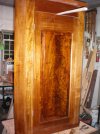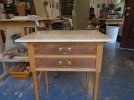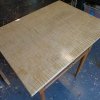With regard for all the woodworking sites on YouTube, I had some time to waste (invest?) in learning something about flattening veneer. Most craftsmen subscribe to the "old" school method of pressing wet veneer between paper sheets until it is dry. But one gentleman used a standard clothes iron to press a sheet of veneer flat and soft, albeit not thoroughly dry. He seems to suggest it can be dried further in a press between sheets of paper. It appears (to me) that using the iron is just a quick way to steam off a lot of the moisture without waiting 24 hrs for the first pressing to do the same?
So, my question for this forum: is using an iron on veneer sheets really a good idea or is it something that just seems to suit this individual craftsman's technique?
Here's a link to his video:
So, my question for this forum: is using an iron on veneer sheets really a good idea or is it something that just seems to suit this individual craftsman's technique?
Here's a link to his video:



